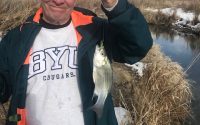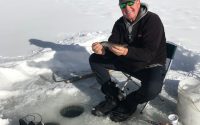Bass Spawn: How Do You Get A Largemouth To Bite?

Bass are wonderful creatures. They have simple brains but their instincts are complex and their behavior can be difficult to read. Let’s explore the art of sight fishing for largemouth bass while on or near their nests, and in the process learn how to quickly determine if a bass is ready to be caught, is not worth waiting on to become ready, and finally, to give you a plan of attack the next time you come across a nesting bass.
No question about it, bass have personalities. Now don’t think for a moment I believe they have feelings, they make conscientious decisions, and have photographic recall. But, they do behave in specific ways that vary from bass to bass.
Holding on beds
The only disclaimer here is that I am assuming you are fishing in relatively clear water so you can see the fish you are trying to catch. When you come across a bed (which looks like an area, usually two feet by two feet in size with a few pieces of small rock or gravel that appears as if someone or something has tried to sweep it clean, located next to it is a piece of wood or grass structure) and a largemouth bass is on or near the bed, gently move your boat away from the area. Not far enough to lose visibility but far enough that the fish continues in its normal routine.
Then, take a pitching stick with a jig tied on and pitch it to the nest. Be sure the bait comes to rest exactly on top of the spot the bass was sitting if it can be determined it was actually on its nest as you first passed by. Just leave the jig there and observe the fish’s behavior. Did it scurry away? It it ignore the bait? Did it leave the entire area, or did it simply move off the nest and then return to stare at your presentation?
The answers to these questions are crucial to understanding this particular bass’s personality and his readiness to be locked on to the nest. If the bass were to scurry away but then returns within a few seconds, that’s good news — he may be catchable. If he leaves the next entirely, and doesn’t return within a minute or five, a couple of things might be at work. First, this bed might not even be his/her bed. The bass may be trying to take the bed of another fish that has either been caught or has momentarily left the nest and is not currently in the vicinity. Or, the bass could be wanting to nest and is willing care for one but is still not ready to occupy the nest until it completes its mating ritual. Either way, unless the bass comes back near the nest within a few minutes, this might be the bass to leave behind to look for greener pastures. The most interesting frustrating bass behavior in this scenario is the bass that returns to the nest and simply stares at the bait. Or better yet, the bass might ignore the bait. That’s when catching the bass become exciting.
As an aside, when I said to throw your jig onto the nest, a certain percentage of bass will immediately inhale the bait and all this writing is not needed. I’ve had many a bass simply turn, identify the intruder and attack. Those kind of bass are the ones you pray for on tournament day, when you’re fishing against the clock.
Now, back to our bass that is staring at the bait. I always keep four or five rods on my deck when fishing a specific bed, each set up with a different bait. Sometimes I vary the color, but most of the time I vary the size of my offering. I start large and them move smaller as time goes on. If the bass refuses to do anything with the jig, I pick up a Senko. The Senko color is not as important as the size(generally 4 to 5 inches) and the way it is rigged. Wacky rigging (a hook brought through the center of the bait with the hook exposed) is by far my favorite presentation. Then, I throw the Senko on the nest in the same manner as the jig. The slow, lumbering drop of the Senko onto the nest at times gets the same response as a jig, a violent attack from the bass.
If that doesn’t work, I move to a Gitzit. Canyon Plastic is a great producer of tubes of all shapes and sizes. I like the 3 1/2 inch tubes in Green Pumpkin the best. If that doesn’t work I move to a dropshot “tini-tube” by Strike King Lures. The dropshot leader needs to allow the bait to stay between four and six inches above the next, right in the fish’s face.
If none of these techniques work I like to go back to my jig and attempt to tough the fish on its nose with the jig. This is to make the fish uncomfortable in his/her current position. If the bass gets frustrated and quickly moves away and then turns on the bait — hold on because he’s about to strike.
Now, let’s talk about the bass that moves off the nest and doesn’t really come back to the nest but stays close. Most bass make a large loop or circle around the nesting area. Sometimes they will move under the boat or just make a large 10 yard circle, always returning to the nest after the “swim about”. Observe to see if each time the bass leaves the nest the circle gets smaller. When this happens I know it’s just a matter of time and patience before that bass is in my live well.
This is only part one of a two-part story. I’ll write about how to manage a very finicky bass and how to catch a bass that has already struck your bait only to come off and is still in the area. Also, I will cover how to catch “cruising fish” that aren’t on any bed, both in the spawn and postspawn realm. So good fishing and we’ll see you next time.










